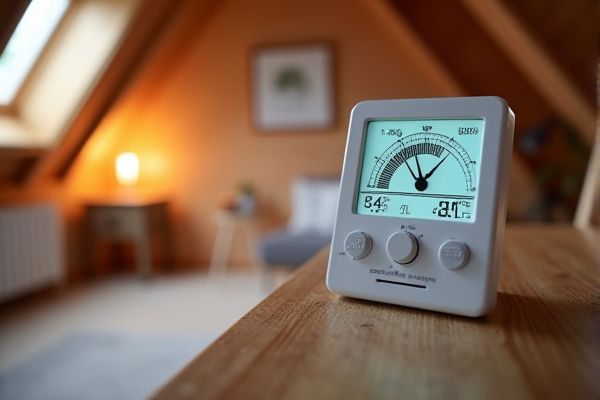
Digital attic thermometers provide precise temperature readings with easy-to-read displays, making them ideal for quick monitoring of your attic's climate. Explore the advantages and drawbacks of each type to determine which thermometer best suits your needs.
Table of Comparison
| Feature | Digital Attic Thermometer | Analog Thermometer |
|---|---|---|
| Measurement Accuracy | High precision with digital sensor technology | Moderate accuracy, affected by manual reading errors |
| Display Type | Digital LCD or LED screen | Analog needle dial |
| Temperature Range | Typically -40degF to 150degF (-40degC to 65degC) | Usually -20degF to 120degF (-29degC to 49degC) |
| Ease of Reading | Clear numeric display, backlit options available | Requires interpretation of needle position |
| Additional Features | May include humidity sensors, memory storage, alerts | Basic temperature measurement only |
| Power Source | Battery-powered (AA, AAA, or button cells) | No power required |
| Durability | Generally sensitive to moisture and impact | Durable, less prone to electronic failure |
| Cost | Higher initial cost due to advanced features | Lower cost, simple design |
| Calibration | Easy digital calibration or automatic | Manual calibration required |
Introduction: Digital vs. Analog Attic Thermometers
Digital attic thermometers provide precise temperature readings with easy-to-read LCD displays, offering higher accuracy and quick response times compared to analog models. Analog attic thermometers rely on dial-based mechanisms and mercury or bimetallic strips, which can be less accurate and harder to interpret in fluctuating temperatures. Your choice depends on whether you prioritize real-time precision and ease of use or simplicity and traditional design.
How Digital Attic Thermometers Work
Digital attic thermometers use electronic sensors, typically thermistors or digital temperature sensors, to measure temperature accurately and convert it into a digital signal displayed on an LCD screen. These devices often feature precise readings with the ability to record temperature trends over time, providing real-time data for monitoring attic conditions. Unlike analog thermometers, they require batteries and may offer additional functionalities like humidity measurement and wireless connectivity for remote monitoring.
How Analog Attic Thermometers Operate
Analog attic thermometers operate using a bimetallic strip that bends in response to temperature changes, causing the needle to move along a calibrated dial. These thermometers rely on mechanical components without requiring batteries or electronic sensors, making them highly durable and low-maintenance. The simplicity of analog thermometers ensures reliable temperature readings in attic environments where electronic devices might be less effective due to humidity or dust.
Accuracy Comparison: Digital vs. Analog
Digital attic thermometers offer superior accuracy compared to analog thermometers, providing precise temperature readings often within +-0.1degF due to advanced electronic sensors. Analog thermometers rely on mechanical components such as mercury or bimetallic strips, which are prone to calibration drift and slower response times, resulting in less reliable measurements. The consistency and ease of reading digital displays make digital thermometers the preferred choice for accurate attic temperature monitoring in HVAC applications.
Ease of Use and Readability
Digital attic thermometers offer enhanced ease of use with clear, backlit LCD screens that display precise temperature readings, making it simple to monitor conditions even in low-light environments. Analog thermometers rely on a dial and pointer system, which can be harder to read accurately at a glance and may require closer inspection. The digital format also often includes features like memory recall and alarms, further improving usability and readability in attic temperature monitoring.
Installation and Maintenance Requirements
Digital attic thermometers require minimal installation, often involving simple battery insertion and sensor placement, while offering easy-to-read LCD or digital displays that can include remote monitoring features. Analog thermometers usually need to be mounted directly in the attic space, with maintenance limited to occasional calibration or cleaning to ensure accuracy. Your choice depends on whether you prefer low-maintenance, precise digital readings or the straightforward, manual operation of analog devices.
Durability and Longevity in Attic Environments
Digital attic thermometers often feature robust materials and sealed designs that resist dust, moisture, and temperature fluctuations common in attics, enhancing their durability. Analog thermometers, with fewer electronic components, may have longer mechanical longevity but can suffer from calibration drift and damage from extreme attic conditions. Choosing a digital thermometer with high-quality sensors and protective casing ensures consistent performance and extended lifespan in harsh attic environments.
Cost Analysis: Digital and Analog Thermometers
Digital attic thermometers generally cost more upfront than analog models, with prices typically ranging from $15 to $50 compared to $5 to $20 for analog thermometers. Despite higher initial costs, digital thermometers offer enhanced accuracy, easy-to-read displays, and additional features such as humidity sensors and temperature alerts, potentially reducing long-term maintenance expenses. Analog thermometers, while cheaper, often lack precision and extra functionalities, making them a budget choice but possibly less efficient for detailed attic climate monitoring.
Pros and Cons of Digital Attic Thermometers
Digital attic thermometers offer precise temperature readings with easy-to-read digital displays, enhancing monitoring accuracy compared to analog models. They often include features like data logging, remote access, and alerts, improving convenience and proactive maintenance. However, digital units require batteries or power sources and can be more expensive and potentially less durable in extreme attic conditions than simpler analog thermometers.
Pros and Cons of Analog Attic Thermometers
Analog attic thermometers offer simplicity and durability with no need for batteries, making them reliable in fluctuating temperatures. Their easy-to-read dials provide immediate temperature readings but lack the precision and data tracking capabilities of digital models. You may prefer analog thermometers for basic monitoring, though they don't support remote access or detailed temperature analytics.
 homyna.com
homyna.com